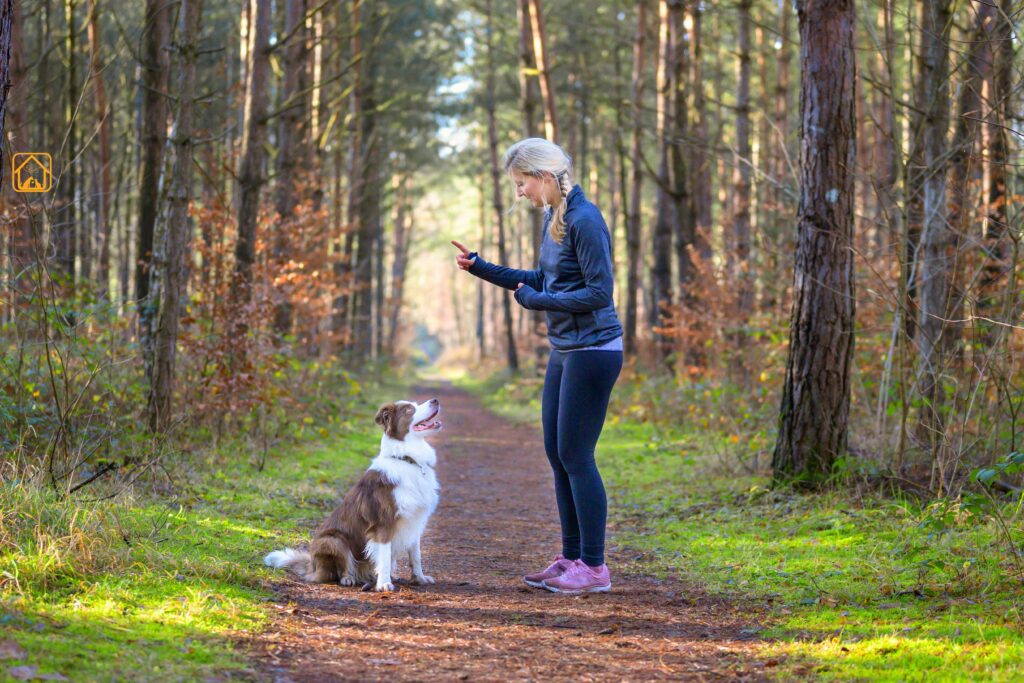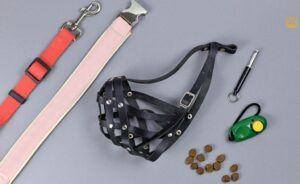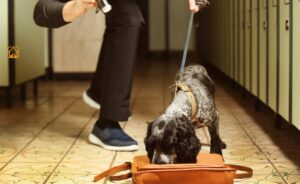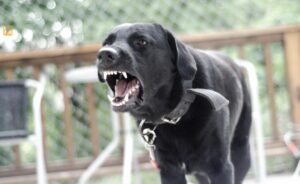Why Sit Training Is Essential for Dogs
If I had a treat for every time a dog parent told me, “He just won’t sit when I ask,” I’d have a mountain of biscuits. Teaching a dog to sit command isn’t just about showing off, it is a basic part of obedience training. It’s about safety, calm greetings, and preventing unwanted behaviours like jumping or dashing out the door.
- Safety at Crosswalks: Asking your dog to sit at curbs keeps them from running into traffic.
- Polite Greetings: Sitting stops dogs from jumping on guests or kids.
- Impulse Control: Sit teaches dogs to pause and think, which helps with many other commands.
Honestly, a solid sit can make visiting the vet, walking in busy parks, or just living together so much smoother. Even advanced trainers use sit as a foundation for more complex skills.
When to Start Sit Training: Age Guidelines for Puppies and Adult Dogs
Wondering when to start sit training for your dog? The good news i —it’s never too early or too late.
Puppies
Most puppies are ready to learn basic commands like “sit” by the time they’re 8 weeks old. At this age, they’re naturally curious and eager to please. The key is to keep sessions short (2–5 minutes), fun, and filled with gentle praise and treats. Start in a quiet area at home so your puppy can focus without distractions.
Adolescents / Adult Dogs
Adolescent and adult dogs can also benefit from sit training. Whether you’re teaching it for the first time or reinforcing what they already know, it’s a great way to build communication and reinforce good manners. Sit training also helps redirect hyper energy and gives your dog a way to earn rewards calmly.
Senior Dogs
For senior dogs, the “sit” command is still very useful but always go easy on their aging joints. Use soft flooring or a mat and avoid long repetitions. Gentle hand signals and a patient tone go a long way with older pups.
No matter your dog’s age, sit training builds trust, structure, and focus. It’s a simple command that fits into every stage of life and can help make everyday situations more manageable for both you and your dog.
Supplies and Preparation for Effective Sit Training at Home
Before you jump into sit training at home, gather a few supplies to set you and your dog up for success:
- High-value treats: Small, soft, and smelly work best for most dogs.
- Clicker: Optional, but great for marking the exact moment your dog sits.
- Leash: Useful for puppies or dogs who get distracted easily.
- Mat or rug: Helps dogs associate a specific spot with calm behaviors.
Pick a quiet spot with minimal distractions. If your dog is excited or distracted, starting in a calm room helps them focus. Have treats ready in your pocket or a pouch, you’ll want to reward quickly!
Step-by-Step Guide: How to Teach a Dog to Sit
Teaching your dog to sit is one of the most useful and easy-to-learn commands. It’s a great starting point for all kinds of training, from basic manners to advanced obedience. Here’s how you can train your dog to sit using a simple, reward-based method that builds trust and cooperation.
Sit Training Step by Step
1. Get Their Attention: Start in a quiet space with minimal distractions. Hold a treat close to your dog’s nose so they stay focused on you.
2. Lure Them into Position: Slowly move the treat upward and slightly back over their head. As their nose follows the treat, their bottom will naturally lower to the ground. Don’t push or force just let their body follow the motion.
3. Mark and Reward: The second your dog’s bottom touches the floor, mark the behavior with a cheerful “Yes!” or a clicker if you’re using one. Immediately give the treat and offer some praise. Timing is key reward right as they sit.
4. Add the Word “Sit”: Once your dog starts sitting consistently with the treat lure, begin saying “Sit” just before moving your hand. Over time, they’ll connect the word with the action.
5. Use a Hand Signal: Introduce a hand signal to go along with the verbal cue. A common signal is an open palm facing up, moved slightly upward.
6. Practice in Short Sessions: Keep training fun and stress-free. Aim for 10–15 repetitions per session, no more than a few minutes at a time. End on a positive note, even if progress is slow.
7. Release Command: Teach a release word like “OK” or “Free” to signal that your dog can get up. This helps prevent confusion and builds better control in different situations.
With patience and consistency, your dog will master the sit command laying the groundwork for better manners and more advanced training
Teaching Sit Without Treats
Some dogs respond better to toys or praise. If your dog isn’t food-motivated, use a favorite toy as the lure or get excited when they sit. The key is making the reward valuable to them.
Tips for Sit Training Consistency
- Always reward promptly, timing is everything!
- Practice in short sessions throughout the day.
- Fade out treats slowly as your dog gets it, but keep praising.
Using Positive Reinforcement and Clicker Training Techniques
Positive reinforcement sit training is the gold standard. Dogs learn fastest when good things happen for the right behavior. Every time your dog sits, reward with a treat, praise, or a click, this strengthens the connection between the command and the action.
- Clicker training for sit: Click the instant your dog’s bottom touches the floor, then treat. This marks the behavior clearly, especially for puppies.
- Verbal praise: Some dogs light up with a simple “Good sit!”
Consistency is key. Every family member should use the same sit command and hand signal. You’ll be surprised how quickly your dog catches on when everyone’s on the same page.
Building Duration, Distance, and Sit with Distractions
Adding the 3 D’s: Duration, Distance, Distraction
- Duration: Ask for a sit and slowly increase how long your dog holds it before releasing. Start with a second or two, then build up to a minute.
- Distance: Once your dog can sit and stay, take a step back. If they hold the sit, reward. Gradually increase the distance.
- Distraction: Practice sit training with distractions like toys, other people, or outside noises. If your dog pops up, lower the difficulty and build back up.
Reality is most dogs need lots of practice with distractions. I once tried to get my dog to sit at a busy park, she acted like she’d never heard the word! Keep it light.
Troubleshooting Common Sit Training Problems and Mistakes
- Dog won’t sit? Try a better treat, change the environment, or break the steps down further. Some dogs respond better to hand signals than words.
- Sits then pops up? Add a release cue like “OK.” Practice duration training for longer sits.
- Only sits with treat visible? Fade the lure over time and reward from your other hand or a treat pouch.
- Inconsistent response? Make sure everyone uses the same cue and timing. Dogs get confused by mixed signals or inconsistent rewards.
Remember, setbacks happen. If your dog forgets, go back a step. They’re not being stubborn, just learning at their own pace.
Advanced Sit Training: Sit-Stay, Sit in Public, and Sit on Mat
Once your dog has mastered the basic sit command, it’s time to level up their skills. Advanced sit training helps build focus, impulse control, and calm behavior in all kinds of situations.
Leveling Up: Beyond Basic Sit
- Sit-Stay is the natural next step. After your dog sits, say “stay” and take a small step back. If they hold the position, return and reward them. Start with just a few seconds and gradually increase the distance and duration. If they move, simply reset and try again. This exercise teaches patience and is useful in everyday situations like waiting at doorways or before crossing streets.
- Sit in Public is about practicing the command in the real-world. Start in a quiet park, then move to busier areas like pet-friendly stores or sidewalks. Use treats and praise to reinforce good behavior when there are distractions. This builds confidence and helps your dog stay calm in new environments.
- Sit on a Mat is perfect for polite behavior at home. Choose a mat or towel and teach your dog to sit there on cue. This is great when guests come over or during meals to keep your dog settled.
With advanced sit training techniques, your dog learns to focus and relax anywhere. Plus, a reliable sit makes life with your pup more enjoyable, trust me, it pays off in every situation. Also, train your dog to follow the next command: Stay.
FAQs: Dog Sit Training
How long does it take to train a dog to sit?
Most dogs learn the basics in a few days to a week with daily, positive practice. Some pups, especially rescues or older dogs, might take longer, but every dog can learn!
Can I train an older dog to sit?
Absolutely. Training an older dog to sit uses the same steps as with puppies. Just keep sessions short and use soft mats if needed for joint comfort.
Do I need treats for sit training?
While treats are the easiest motivator, some dogs prefer toys or praise. The key is finding what your dog values most. Over time, you can phase out treats and rely on praise or play.
What’s the best hand signal for sit?
The classic dog sit command hand signal is an open palm, facing up, moving upward. Be consistent so your dog learns to recognize it even in noisy places.
My dog only sits at home, how do I teach sit in public?
Practice in different locations, starting with quiet outdoor spots. Use high-value treats and be patient. Gradually add more distractions as your dog gains confidence.
What are common mistakes in sit training?
Common dog sit training mistakes include repeating the command too often, inconsistent rewards, or moving the treat too quickly. If your dog struggles, slow down and reward the smallest progress.
How can I make my dog’s sit more reliable?
Practice daily, vary the environment, and always reward a good sit. Use duration training for longer sits, and don’t forget to add distractions gradually.
Conclusion
Sit training is one of the most important commands your dog can learn. It builds focus, manners, and sets the foundation for more advanced skills. Whether you have a playful puppy or an older rescue, consistent practice and patience go a long way. Keep training fun, use positive rewards, and celebrate small wins.



